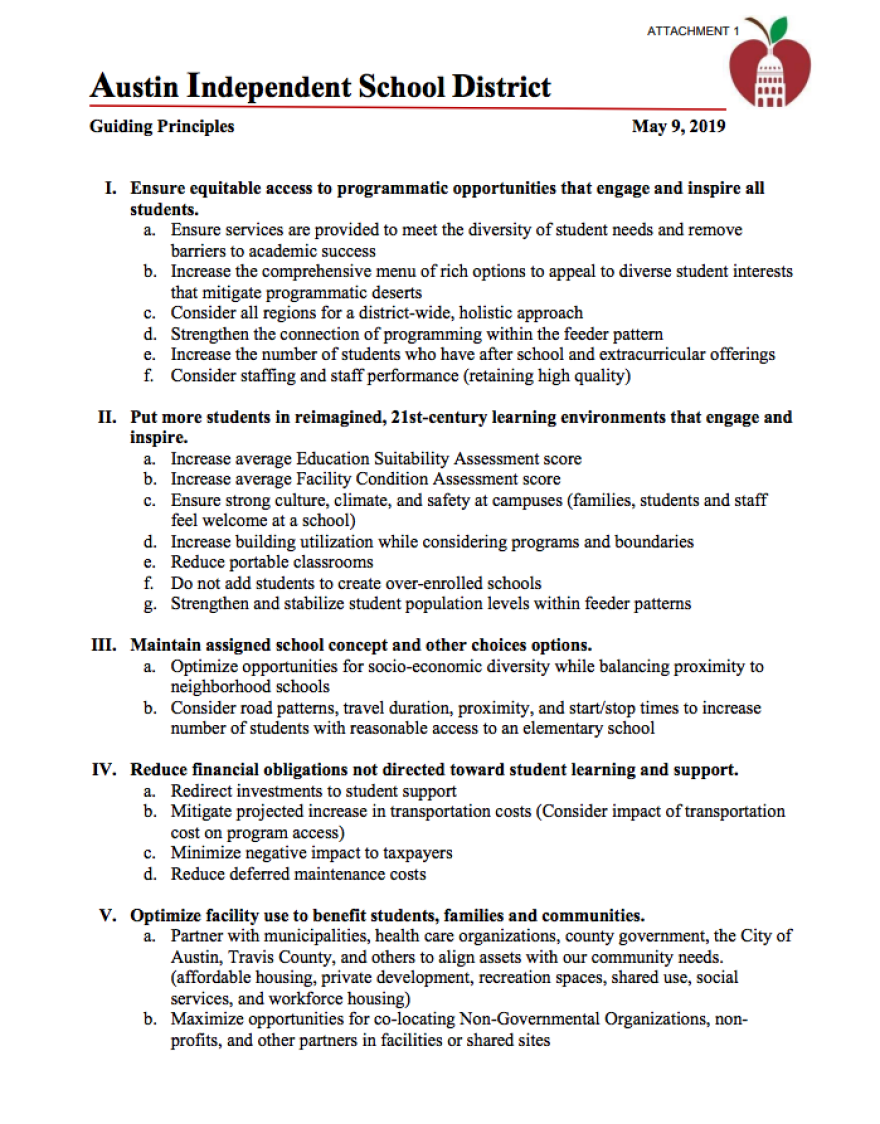Come Monday, the Austin Independent School District will be one step closer to closing or consolidating schools. Facing declining enrollment, a budget shortfall and aging schools, the district says the move will help it avoid bankruptcy and better utilize its property.
Still, it's a move that will require some tough decisions. So, Monday night, the school board will approve its rubric to decide which schools will stay open. So how did the district get to this point?
Why do this now?
"Austin is changing," said superintendent Paul Cruz at a press conference Friday. "The way Austin changes Austin ISD will also change."
One of the biggest challenges associated with those changes – for both the district and Austinites – are ever-rising housing costs. For the district, it's meant that fewer families can live in its boundaries, opting to move to suburbs instead.
On top of that, of the parents who are staying in the district, some are choosing charter schools over AISD schools. Those realities have led to a drop in enrollment over the last 10 years, and predictions say that drop will continue. The district is also struggling financially, partly because of the low enrollment and partly because AISD sends hundreds of millions of dollars back to the state in recapture.
It's also struggling to maintain all of its school buildings, many of which are under-enrolled. If the district doesn't close or consolidate, it could eventually face bankruptcy.
Still, district officials have previously emphasized these guiding principles won't rely purely on whether a school is under-enrolled, as that could lead to the closure of historically under-enrolled East Austin schools.
How is the district making these decisions?
If the board approves the guidelines, which it refers to as guiding principles, they'll guide its decisions on closure or consolidation.

Trustees will weigh a closure against how it would benefit the district overall, keeping in mind its goals of making sure students have access to programs and are able to attend a renovated school. They also want to save money on spending outside of the classroom (think buses, utilities and general upkeep), maintain school choice options for families and use school buildings for other community needs.
What schools are going to be closed? And where?
This map is another tool the district will use to make their decisions. AISD will look at every region's enrollment, program offerings, the age of buildings in that region and the cost of repairs at current schools, among other things.
Parents have wondered whether this map will change which schools their children can attend, as many people buy or rent in certain neighborhoods so their kids can go to specific schools. While this plan could change where students attend, the map won't dictate those changes.
Trustee Cindy Anderson says the closures and consolidations could ultimately change where students attend in the hopes of simplifying the district's feeder patterns.
"For example, you've got one elementary school [that] might split between multiple middle schools, the middle schools split between multiple high schools," Anderson said.
She said the district would prefer to keep students together as they head on to their next middle or high school, which, Anderson says, would keep curriculum consistent across all schools.
"We've got these great programs, but you might have one that has a fine arts strand, you might have a STEM strand in another," she said. "So, if your child is engaged in one particular area of interest but then their high school doesn't support it, it becomes very challenging."
So What's Next?
At the end of this process, a school could close and consolidate with a nearby school. It could get new programs that the neighborhood previously didn't have. And boundaries and feeder patterns could be adjusted for families.
Superintendent Cruz said he understands that these possible changes are scary and uncomfortable for some families.
"We're all parents, we understand what this is and what this means to our students, to our families and to us," he said. "We're going to be very respectful of that."
Trustee Amber Elenz, who represents Central and West Austin, said while some of her constituents have expressed concern, she thinks this process will make the district more equitable. But, she admits, it won't be easy.
"There is going to be pain, but there is going to be profit in every space," she said. "If we look at ourselves as these little individual units all the time ... which we've allowed, that's where we get in trouble. People dig in their heels and they can't be open-minded, so I'm asking my constituents to be open-minded and help us find solutions that work for all."
The board will vote to approve the guiding principles Monday. It will then spend the summer debating the closures and consolidations before its final vote in October. Once approved, these changes could take up to three years to be fully implemented.


